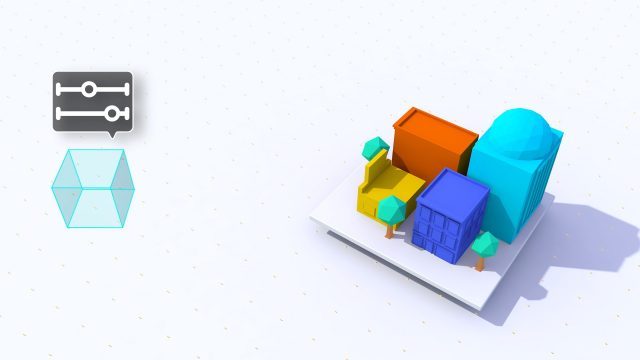Combining Real-time Elements for Interactive Gameplay
Of course, one challenge with synthetic light-field rendering approaches is that they’re typically static (because if you wanted to generate a series of light-field ‘frames’ you’d again run into issues with file size). One approach to get around that issue is to combine the light-field scene with traditional real-time assets.
The Star Wars Seurat scene demonstrated just that using a real-time model of the Rogue One droid character K-2SO who was strolling about the scene, and his real-time reflection was seamlessly composited against the shiny floor that was part of the Seurat scene. Because the model is running in real-time, I could see that he didn’t look quite as shiny and high-quality as the environment around him (because any real-time elements are constrained by the usual limits of mobile graphical capabilities). But the real-time nature means he can be interactive like in a traditional game, opening the door to creating real gameplay within these highly detailed Seurat environments.
Interestingly, Google also told me that the Seurat-generated environment produces real geometry. That means an easier way for developers to integrate the environment and the real-time assets together. For instance, if a developer wanted to allow me to shoot the robot and make sparks fly off of him in the process, those sparks could correctly bounce off of the floor, and indeed, K-2SO’s robot corpse could correctly fall onto it.
Adjustable Fidelity
Although Google has offered limited technical explanations of how Seurat actually works, nor if/when the company will offer it up publicly, it seems to be a rapidly maturing tool. Google’s VP of VR and VR, Clay Bavor, told me that the output can range in visual fidelity depending upon how much overhead the developer wants to retain for real-time interactive elements. That option, he said, is about as simple as a set of sliders.
 So if a developer simply wants to offer a pretty environment for the player to look around, they would tell Seurat to render at the maximum fidelity that the mobile VR device could handle. But if the developer wanted to retain 50% of the processing power for real-time assets so that the environment can contain interactive characters and other dynamic content, the dev can notch down the Seurat output quality to ensure some open overhead for those extra elements.
So if a developer simply wants to offer a pretty environment for the player to look around, they would tell Seurat to render at the maximum fidelity that the mobile VR device could handle. But if the developer wanted to retain 50% of the processing power for real-time assets so that the environment can contain interactive characters and other dynamic content, the dev can notch down the Seurat output quality to ensure some open overhead for those extra elements.
– – — – –
Although Seurat requires developers to specify specific viewing areas—unlike a normal real-time environment where the viewer could choose to go anywhere—it seems like there’s a category of games that could make excellent use of Seurat to bring desktop-quality graphics to mobile VR: genres like narrative/character-focused pieces, turret/static/wave shooters, point and click adventure, and more. We’ll have to wait and see what developers can do with Seurat, and what challenges may yet be unidentified, but for now the potential of the technology seems very high and I’m excited to see how it can be used to improve the mobile VR experience.






